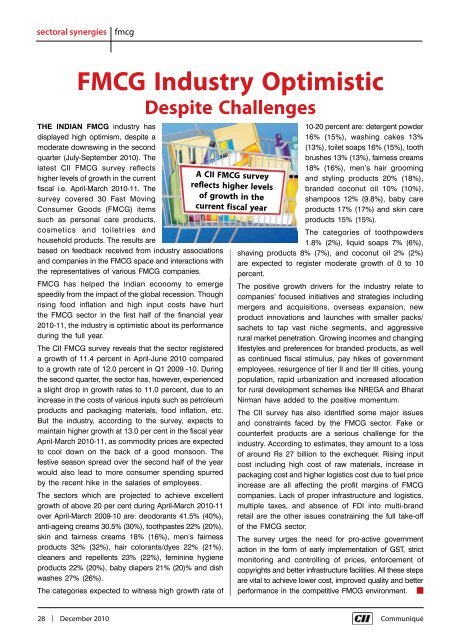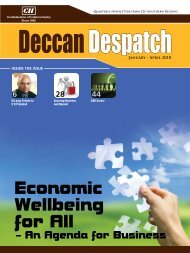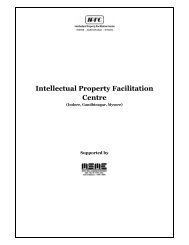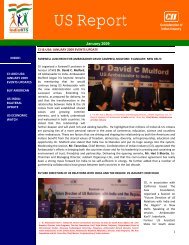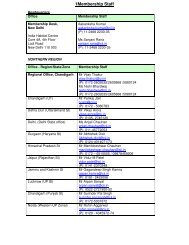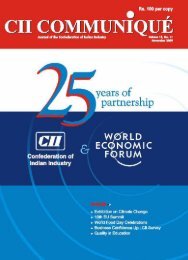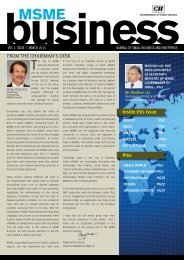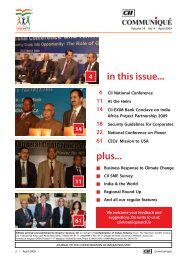CII Communique - December, 2010
CII Communique - December, 2010
CII Communique - December, 2010
You also want an ePaper? Increase the reach of your titles
YUMPU automatically turns print PDFs into web optimized ePapers that Google loves.
sectoral synergies<br />
fmcg<br />
FMCG Industry Optimistic<br />
Despite Challenges<br />
The Indian FMCG industry has<br />
displayed high optimism, despite a<br />
moderate downswing in the second<br />
quarter (July-September <strong>2010</strong>). The<br />
latest <strong>CII</strong> FMCG survey reflects<br />
higher levels of growth in the current<br />
fiscal i.e. April-March <strong>2010</strong>-11. The<br />
survey covered 30 Fast Moving<br />
Consumer Goods (FMCG) items<br />
such as personal care products,<br />
cosmetics and toiletries and<br />
household products. The results are<br />
based on feedback received from industry associations<br />
and companies in the FMCG space and interactions with<br />
the representatives of various FMCG companies.<br />
FMCG has helped the Indian economy to emerge<br />
speedily from the impact of the global recession. Though<br />
rising food inflation and high input costs have hurt<br />
the FMCG sector in the first half of the financial year<br />
<strong>2010</strong>-11, the industry is optimistic about its performance<br />
during the full year.<br />
The <strong>CII</strong> FMCG survey reveals that the sector registered<br />
a growth of 11.4 percent in April-June <strong>2010</strong> compared<br />
to a growth rate of 12.0 percent in Q1 2009 -10. During<br />
the second quarter, the sector has, however, experienced<br />
a slight drop in growth rates to 11.0 percent, due to an<br />
increase in the costs of various inputs such as petroleum<br />
products and packaging materials, food inflation, etc.<br />
But the industry, according to the survey, expects to<br />
maintain higher growth at 13.0 per cent in the fiscal year<br />
April-March <strong>2010</strong>-11, as commodity prices are expected<br />
to cool down on the back of a good monsoon. The<br />
festive season spread over the second half of the year<br />
would also lead to more consumer spending spurred<br />
by the recent hike in the salaries of employees.<br />
The sectors which are projected to achieve excellent<br />
growth of above 20 per cent during April-March <strong>2010</strong>-11<br />
over April-March 2009-10 are: deodorants 41.5% (40%),<br />
anti-ageing creams 30.5% (30%), toothpastes 22% (20%),<br />
skin and fairness creams 18% (16%), men’s fairness<br />
products 32% (32%), hair colorants/dyes 22% (21%),<br />
cleaners and repellents 23% (22%), feminine hygiene<br />
products 22% (20%), baby diapers 21% (20)% and dish<br />
washes 27% (26%).<br />
The categories expected to witness high growth rate of<br />
A <strong>CII</strong> FMCG survey<br />
reflects higher levels<br />
of growth in the<br />
current fiscal year<br />
10-20 percent are: detergent powder<br />
16% (15%), washing cakes 13%<br />
(13%), toilet soaps 16% (15%), tooth<br />
brushes 13% (13%), fairness creams<br />
18% (16%), men’s hair grooming<br />
and styling products 20% (18%),<br />
branded coconut oil 10% (10%),<br />
shampoos 12% (9.8%), baby care<br />
products 17% (17%) and skin care<br />
products 15% (15%).<br />
The categories of toothpowders<br />
1.8% (2%), liquid soaps 7% (6%),<br />
shaving products 8% (7%), and coconut oil 2% (2%)<br />
are expected to register moderate growth of 0 to 10<br />
percent.<br />
The positive growth drivers for the industry relate to<br />
companies’ focused initiatives and strategies including<br />
mergers and acquisitions, overseas expansion, new<br />
product innovations and launches with smaller packs/<br />
sachets to tap vast niche segments, and aggressive<br />
rural market penetration. Growing incomes and changing<br />
lifestyles and preferences for branded products, as well<br />
as continued fiscal stimulus, pay hikes of government<br />
employees, resurgence of tier II and tier III cities, young<br />
population, rapid urbanization and increased allocation<br />
for rural development schemes like NREGA and Bharat<br />
Nirman have added to the positive momentum.<br />
The <strong>CII</strong> survey has also identified some major issues<br />
and constraints faced by the FMCG sector. Fake or<br />
counterfeit products are a serious challenge for the<br />
industry. According to estimates, they amount to a loss<br />
of around Rs 27 billion to the exchequer. Rising input<br />
cost including high cost of raw materials, increase in<br />
packaging cost and higher logistics cost due to fuel price<br />
increase are all affecting the profit margins of FMCG<br />
companies. Lack of proper infrastructure and logistics,<br />
multiple taxes, and absence of FDI into multi-brand<br />
retail are the other issues constraining the full take-off<br />
of the FMCG sector.<br />
The survey urges the need for pro-active government<br />
action in the form of early implementation of GST, strict<br />
monitoring and controlling of prices, enforcement of<br />
copyrights and better infrastructure facilities. All these steps<br />
are vital to achieve lower cost, improved quality and better<br />
performance in the competitive FMCG environment.<br />
28 | <strong>December</strong> <strong>2010</strong> Communiqué


